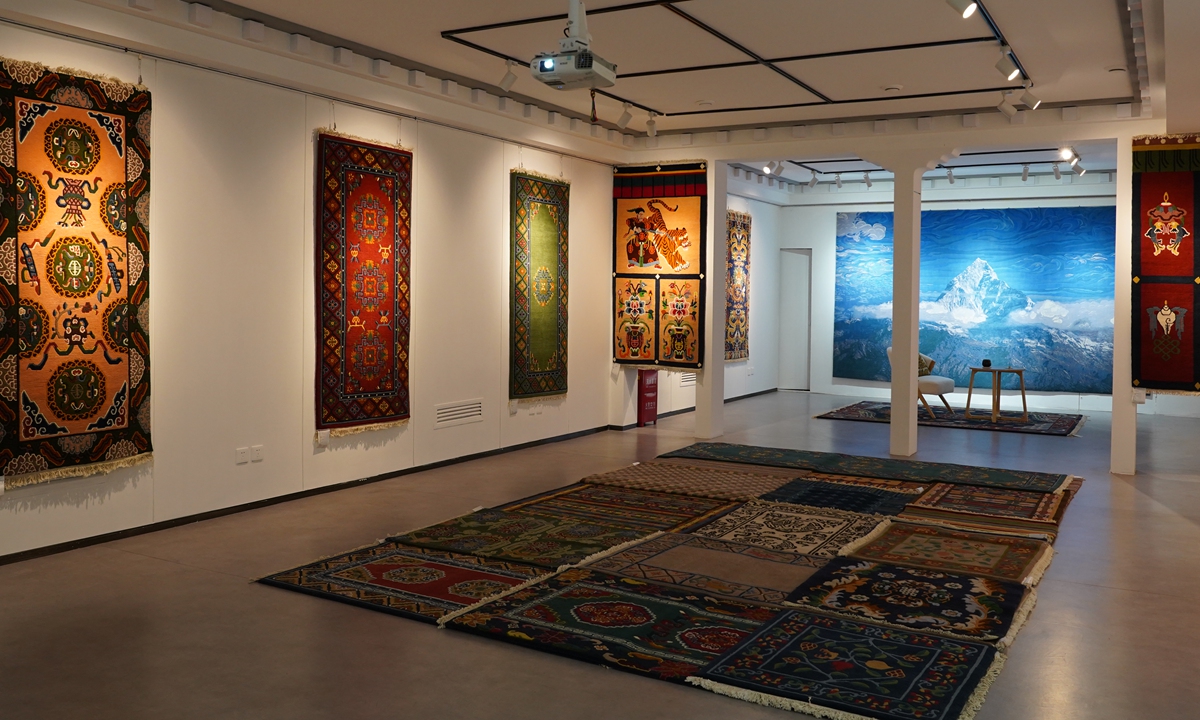ARTS / ART
Traditional Tibetan rugs turn to technology to reach wider appreciation
Weaving the future

Craftswoman Sonam Pemdo poses for a photo with handmade Tibetan rugs. Photo: Courtesy of Xu Chengcheng

An exhibition of handmade Tibetan rugs at Beijing's 798 Art Zone in August 2022 Photo: Courtesy of Xu Chengcheng
Editor's Note:Every year around the end of August and the beginning of September, the Shoton Festival, one of the most important traditional festivals of the Tibetan ethnic group, is held in Southwest China's Xizang Autonomous Region. During the seven-day festival, people eat yogurt, enjoy Tibetan opera, view thangka paintings and enjoy Buddhist exhibitions.
From 2006 to 2018, China's central government invested a total of 195 million yuan ($28.26 million) into the protection of Xizang's intangible cultural heritage.
In this series we will explore these cultural treasures. Following thangka paintings comes Tibetan rugs, upon which locals sit as they talk, laugh and enjoy the festival with friends and family.
Tibetan rugs, one of China's important intangible cultural heritages, require a lot of patience and time to make. While necessary, this factor has acted as a barrier preventing Tibetan rugs from expanding further into the commercial market.
Fortunately, this very beautiful yet still practical art is now maneuvering its way past these barriers through semi-industrialization, allowing them to be admired and used by a wider population beyond Southwest China's Xizang Autonomous Region.
Time-consuming handicraft
Throughout August, inside an exhibition hall in Beijing's bustling 798 Art Zone, two ajias (elder sister in Tibetan) dressed in traditional dark violet Tibetan robes sat in front of a loom and deftly used a set of heavy steel tools to turn woolen thread in a table-sized rug sporting a beautiful floral pattern.
The two women, Kesang and Sonam Pemdo, have worked at a rug factory in Xigaze, Xizang, for more than 30 years. Over the summer, they came to Beijing for the first time and brought their art into the limelight.
Their decades-long experience has turned them into experts in making Tibetan rugs, yet sadly they are also just two of the few remaining handicraftsmen in Xizang who have mastered this ancient art, which has seen less new blood pick up the torch.
"We need at least a month to finish a two-square-meter rug with only simple patterns like this one," Kesang said in Tibetan, speaking to the Global Times through a translator.
"It takes more than a massive investment of time or expensive materials, of more importance is the patience and perseverance that is needed to complete a rug," she added.
This time-consuming ancient handicraft may seem out of place in today's efficiency-focused society, which is why the two aijias' children chose to pursue office jobs after college instead of inheriting the traditional handicraft.
"It's totally understandable. If you want to make an outstanding rug, you need to focus on this craft from a very young age and spend the whole day at it," added Xu Chengcheng, a spokesperson for the Gang-Gyen Carpet&Rug company.
"And it's not just us who have this problem. Rug weavers in West and South Asian countries, including Iran and India, are experiencing the same issues and so are seeking ways to modernize the handicraft and make it more customer orientated."
Technological leaps
Since the 1980s, a number of rug factories have sprouted up in the Xizang region, hiring massive amounts of workers to make handmade rugs and carpets. However, the rugs they make are not only household necessities for locals but also artworks.
There are many theories concerning the origin of Tibetan rugs. Many experts believe that the cold temperatures due to the region's high altitude are the main reason why rugs are so essential. Ethnic Tibetans use local materials - wool from Tibetan highland sheep - to make thick and warm blankets, which are also used to welcome overnight guests when they arrive on cold days.
The most popular pattern among locals is the tiger rug, a functional yet decorative symbol that locals put by the front door of the living room or a temple to ward off misfortune.
In the Xizang region, tigers are used to praise heroes and decorate amulets. Experts believe that tiger blankets date back to around 1,300 years ago.
Decorative patterns are not the only eye-catching feature of Tibetan rugs, the weaving techniques used to make this national intangible cultural heritage are also just as important.
Using an intricate set of tools, artisans pass warp and weft threads through a loom and compact them together inch by inch.
An exquisite handmade Tibetan rug involves several steps, from wool selection and spinning yarn to dyeing, weaving and cutting. Each step is the foundation for the next, so workers need to be extremely careful to avoid mistakes.
In order to improve efficiency and to improve sales of local rug brands, many rug factories in Xizang began to research ways to upgrade the industry back in the 1980s.
"We opened a new factory that incorporates developments in technology into our machinery and production lines," Xu told to the Global Times.
Gang-Gyen is a new industrialized rug factory using technologies such as hand tufting tools, which helped cut production time in half.
These mass produced Tibetan rugs are used as decorations in hotels, market halls and offices, and feature a broader variety of decorative patterns that suit the preferences of a wider range of customers.
This industrial innovation has helped provide a stable source of income to many locals. Gang-Gyen is not the only factory to do so; many other Tibetan rug factories such as the well-known Shengyuan Carpet company have been keeping up with the times by introducing technology such Axminster machinery into production.
Now that the one-month exhibition in Beijing is over, the two ajias' next stop is Shenzhen.
"Tibetan rugs are a craft that grows from the land and is related to life. The designs of these local craftsmen are imaginative, rough, cool and trendy," commented Xu.


